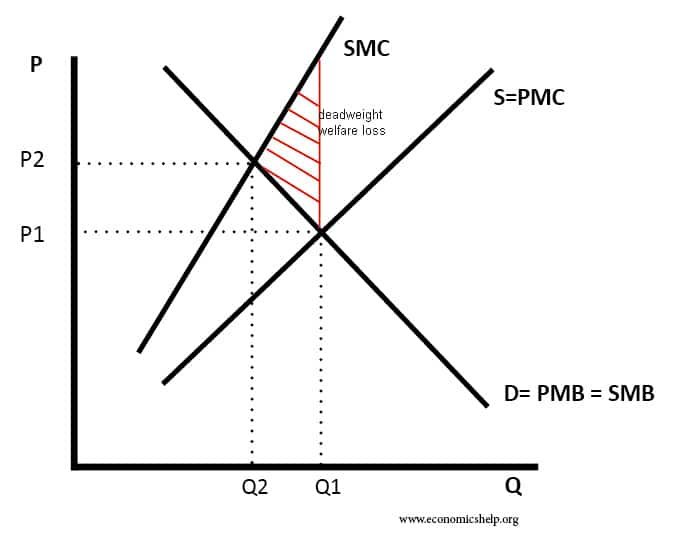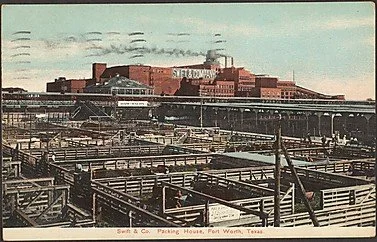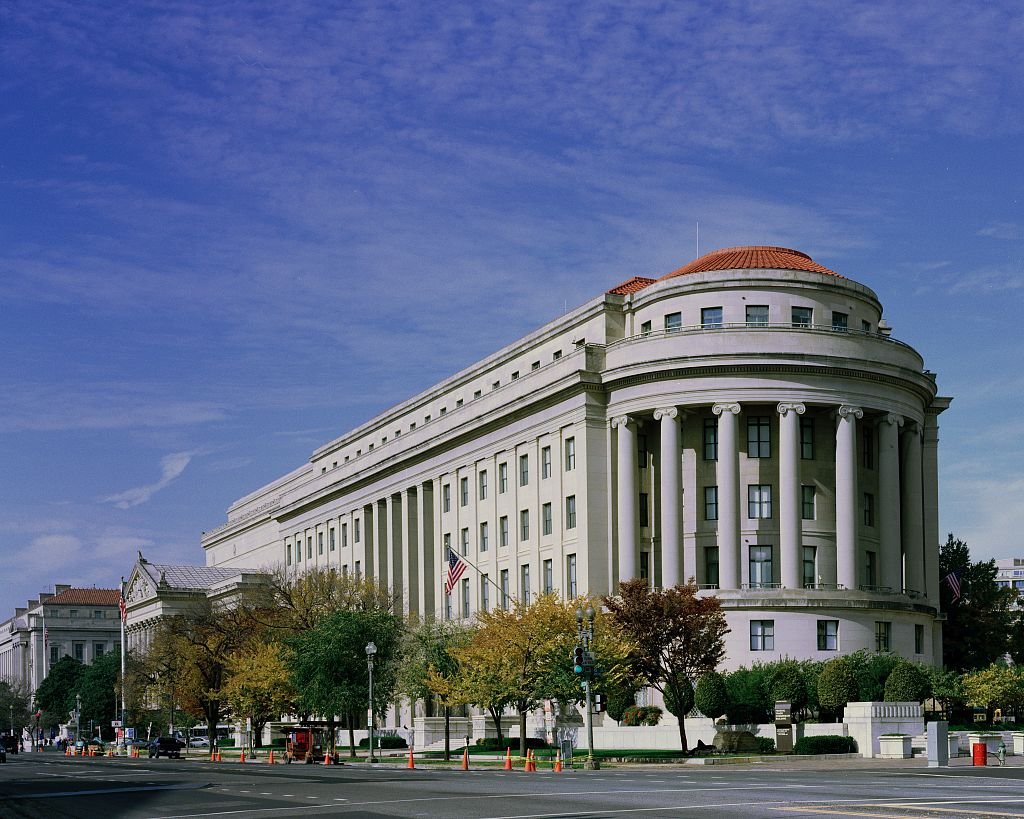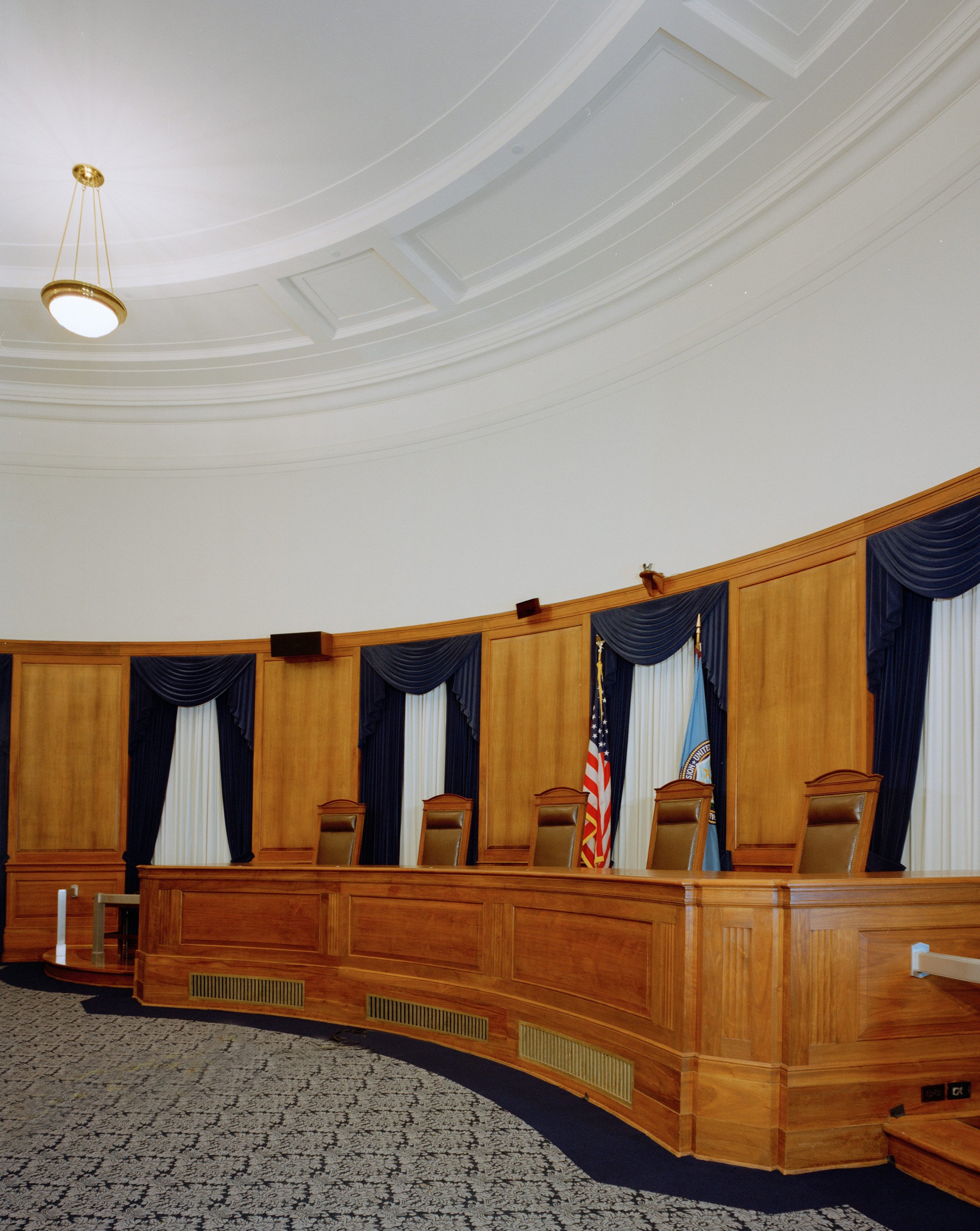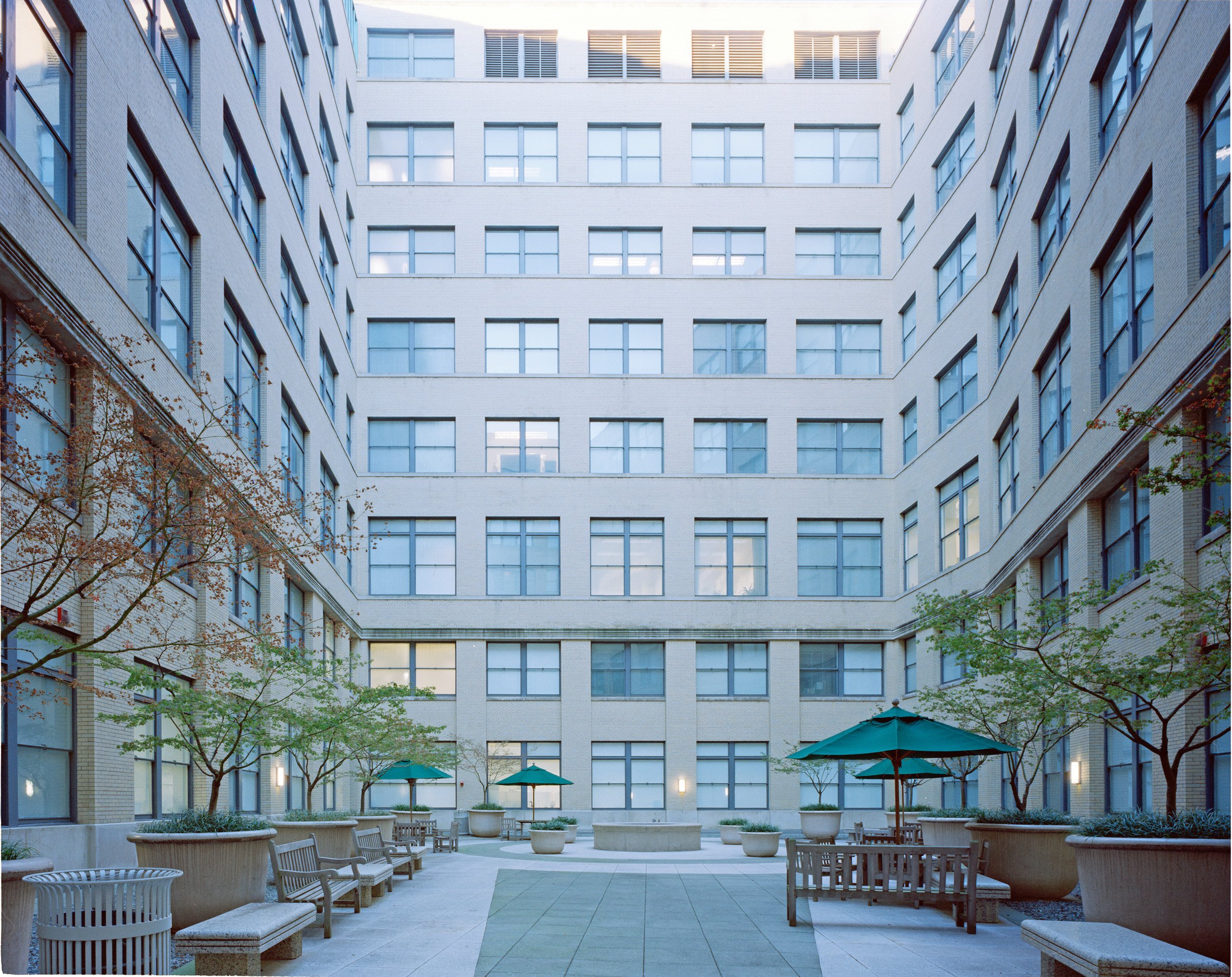Gallery
Explore photographs relevant to the casebook, organized by chapter. Many of the photos are also links (hover your cursor over the photo to see).
Chapter One
Page 4 -- "Man Controlling Trade" consists of two larger-than-life sculptures in front of the Federal Trade Commission (FTC), one of which is pictured here. If you are interested, the General Services Administration has produced a brief video about the history behind these two iconic statues. The statues are making a point. The horse is trade. It is powerful, useful, and impressive. But it is also potentially dangerous and destructive. It must be tamed, reined in. For that, we need someone or something that is also powerful and has some brains. To the rescue comes the FTC, the man controlling trade. The premise is that an unregulated market will do as much harm as good; a regulated market can be put to work for society's benefit without causing harm. This is an optimistic, even heroic, view of regulation and regulators. But it is not one that every observer accepts.
Page 4 -- Artist David Spear has produced a contemporary but intentionally anachronistic version of the same subject.
Page 5 -- Here is a standard graph – a version can be found in any economics textbook – illustrating negative externalities. The Y axis (“P”) shows the price of a good or activity; the X axis (“Q”) shows its quantity. SMC = Social Marginal Cost; SMB = Social Marginal Benefit; PMC = Private Marginal Cost; PMB = Private Marginal Benefit; S = Supply; D=Demand. The graph illustrates that in the presence of negative externalities, too much of a good is produced (Q1); were those costs not external, i.e. if social and private marginal benefit were identical, then the point at which costs exceeded benefits would be further to the left (at Q2).
Page 12 -- Two behavioral economists have been awarded the Nobel Prize: Daniel Kahneman (2002) and Richard Thaler (2017). Kahneman (who by training is a psychologist, not an economist) is pictured here.
Page 12 -- Richard Thaler
Page 16 -- Arthur Cecil Pigou (1877-1959) was educated at, and for many years taught at, Cambridge University. His best-known and most important work was The Economics of Welfare (1920), which developed the concept of externalities (first articulated by Pigou’s teacher, Alfred Marshall) and argued that negative externalities should be taxed and positive externalities subsidized.
Pages 31-32 -- An editorial cartoon from the Oct. 27, 1909 Wall Street Journal (though originally appearing in the Des Moines Register and Leader) depicting the judicial constraints on the ICC. The caption reads: "The Interstate Commerce Commission: 'I can't see how I'm ever goin' to amount to anything like this.'"
Page 33 -- James Landis, cited at the bottom of the page, was a member of the FTC, Chair of the SEC, dean of the Harvard Law School, chair of the CAB, and an advisor to President Kennedy (in which capacity he gets much of the credit for the creation of the Administrative Conference of the United States). His book, The Administrative Process, remains influential. His illustrious career ended in scandal and despair after a criminal conviction for failure to pay income taxes. The link will take you to his obit, which was front-page news in the NY Times.
Chapter Two
Page 48 -- The not very awe-inspiring headquarters of J.W. Hampton Jr. & Co. in Queens, NY, in business since 1865.
Page 50 -- NRA Blue Eagle. The blue eagle — holding a gear and lightning bolts in its talons — was the symbol of the National Recovery Administration. Prior to the Court's decision in Schechter, firms that adhered to a Code of Fair Competition posted the blue eagle sign. (The Philadelphia Eagles football team, established in 1933, was apparently named after the NRA Blue Eagle.) The decision in Schechter doomed the eagle.
Page 50 -- New Deal political cartoon. An editorial cartoon from the 1930s celebrating the Supreme Court's holding the line against executive overreach in Schechter and other cases. Note the number of documents labelled "code" in the dismayed officials' pockets.
Page 50 -- From the Department of No Hard Feelings. The New York Times reports that despite their clash with New Deal excess, everyone in the Schechter clan voted for FDR in the subsequent presidential election.
Page 91 -- Jagdish Rai Chadha.
Page 91 -- Representative Joshua Eilberg (D-Pa). Eilberg chaired the Subcommittee on Immigration, Citizenship, and International Law of the House Judiciary Committee. It was he who convinced the House (or whatever members happened to be in the chamber at the time) to veto the AG's suspension of removal of Chadha and five others. His explanation, pretty much in full, was: "It was the feeling of the committee, after reviewing 340 cases, that the aliens contained in the resolution did not meet [the] statutory requirements, particularly as it relates to hardship; and it is the opinion of the committee that their deportation should not be suspended."
Page 104 -- Witnesses at an oversight hearing being sworn in before their testimony and questioning. Notice how absolutely delighted they all seem to be there.
Page 104 -- More keenly excited oversight hearing witnesses
Page 104 -- Congressman John Dingell, in his Chairman's seat, looking benign.
Page 124 -- Merrick Garland being sworn in before before appearing before the Judiciary Committee, which was considering his appointment as Attorney General. The Garland saga, including the fact that no such photograph exists in the context of his nomination to the Supreme Court, is a reminder of the potency of the Senate's power of advice and consent.
Page 131 -- A contemporary newspaper article about the firing of Frank Myers. By the time the case reached the Supreme Court, the "Myers" in the caption was not Frank but Lois, Frank's widow and the administratrix of his estate. Frank died in 1924, after losing in the Court of Claims and before the Supreme Court heard his case. Cf. Humphrey's Executor v. United States.
Page 132 -- This is, of course, President Franklin Delano Roosevelt. It seems unlikely that this is a photo of him actually writing his message firing William Humphrey, but who knows? -- anything is possible. The link will take you to a recording of FDR's remarks at the laying of the cornerstone for the FTC building on July 12, 1937.
Page 132 -- William Humphrey, FDR's least favorite FTC Commissioner. Humphrey was appointed by President Hoover in 1931; FDR purported to fire him on October 8, 1933; he died on February 14, 1934. The lawsuit filed by the executor of his estate sought four months of back pay.
Chapter Three
Page 236 -- A Los Angeles newsboy (the one wearing the fedora) at the corner of Hollywood and Vine around the time of the Hearst case. As the picture shows, the "newsboys" (or, sometimes, "newsvendors") represented by the Los Angeles Newsboys Local Industrial Union No. 75, C.I.O. were not necessarily all that young. In the words of the Court: "The [bargaining] units which the Board determined to be appropriate are composed of those who sell full-time at established spots. Those vendors, misnamed boys, are generally mature men, dependent upon the proceeds of their sales for their sustenance, and frequently supporters of families. Working thus as news vendors on a regular basis often for a number of years, they form a stable group with relatively little turnover, in contrast to schoolboys and others who sell as bootjackers, temporary and casual distributors."
Page 238 -- The Swift & Co. plant in Fort Worth, TX. A postcard from the first few decades of the 20th century showing the plant where Skidmore and his colleagues were engaged to wait (or were waiting to be engaged).
Page 243 -- The Chevron refinery in Richmond, California. This facility could be a single "source" under the bubble policy challenged in the case.
Page 254 -- A Mead Daily Planner of the sort at issue in U.S. v. Mead Corp. Is it bound? Is it a diary?
Page 256 -- FCC v. Fox. Paris Hilton and Nicole Richie at the 2003 Billboard Music Awards, when the latter offered her insights about the challenges of cleaning a Prada purse.
Page 328 – Historic Marker at Overton Park in Memphis, TN. Overton Park may be the only administrative law decision that gets a historic marker at the site of the controversy. For pictures of the park itself, the link will take you to the website of Citizens to Protect Overton Park — not the lawsuit, the organization, which, like the park itself, still seems to be going strong.
Page 338 -- Automatic seatbelts. A picture of an automatic seat belt, c. 1980, shown with the driver's door open. When the door is closed, the piece at the top of the belt slides backward along a track, ending up behind the driver's left shoulder.
Page 343, n. 12 -- VW ad. In 1978, VW ran this ad touting its automatic belts. The ad observes: "Of course, by 1984 every new car in America must have a passive restraint system. Transportation Secretary Adams says so. But we didn't wait to be told. Only the Rabbit 'L' has automatic seatbelts today. And has had them since 1975." It also ends with a striking tag line: "Volkswagen doesn't think like any old car company. Volkswagen thinks like a mother." One vote for [m]aternalism as a justification for regulation!
Page 368 -- Any early version of the 2020 census form (this was sent to some households as part of a test) that included the controversial citizenship question that was removed from the final, official form. The photo links to a 2018 Census Bureau publication that offers the party-line justification for the question (scroll to p. 7).
Page 370 -- Plaintiffs in the Regents case descending the Supreme Court steps after the oral argument in Nov. 2019.
Chapter Four
Page 387 -- Professor Lon Fuller (1902-1978). The Morality of Law, excerpted here, grows out of a famous 1958 exchange between Fuller and H.L.A. Hart in the pages of the Harvard Law Review. Hart was the leading positivist of his time; Fuller argued that law had, and should aspire to, an internal morality.
Page 399 -- Secretariat. Photos of holding companies are hard to find. So, in a trade-off of interest against relevance, here is the 1973 Triple Crown winner, regarded by many as the greatest Thoroughbred racehorse ever. There is a connection: the Chenery family owned Meadow Stable, which bred and raised Secretariat. Photos often show Secretariat with Penny Chenery, who was the daughter of Chris Chenery, one of the principals in the litigation.
Chapter Five
Page 466 -- Octane label. The FTC regulations challenged in National Petroleum Refiners Ass'n remain in place. Though they have been updated over the years, they still require that gasoline retailers post a label indicating the octane rating of the gasoline that comes out of a pump. See 16 CFR 306.10 (requiring posting), 306.12 (setting out specific requirements for the layout, type size, and color (yellow with black print) of the posted labels). This is an example of the label, which will be instantly recognizable.
Page 495 -- Vermont Yankee Power Plant. A photo of the Vermont Yankee plant, which stopped operations in late 2014.
Page 521 -- Normal Chest X-Rays.
Page 521 -- Opaque chest x-rays. These four images are more opaque (more white area) than the normal ones. Under the PPL challenged in American Mining Congress, an opacity level above a specific number qualified as a "diagnosis" of a relevant illness.
Page 556 -- William French Smith, Ronald Reagan, Drew Lewis (L-R). Flanked by the Attorney General and the Secretary of Transportation, the President speaks to the press during the air traffic controllers' strike, August 3, 1981.
Page 556 -- The (gloomy) 1982 Labor Day parade in New York City. The firing of the controllers and decertification of PATCO is generally seen as a critical turning point in American labor history, marking the decline of the power of public unions in particular and labor in general.
Page 596 -- Flyer. This is the cover memo that accompanied the flyer that identified Edward Davis as someone "known to be active in this criminal field," i.e. shoplifting. This sheet was followed by five pages of photographs.
Page 596 -- Flyer. This is the second page of photos; Edward Charles Davis III is third from the bottom in the middle column.
Page 655 -- Nutritional Facts label. Compare the old and new version of this label. Which is better? Why? What goals does the FDA seem to have had in mind in making the changes it did?
Page 658 -- New cigarette labels. FDA's efforts to require graphic warning images (not just text) on cigarette packages continue, as does litigation to block such requirements. Here is one of nine images a 2020 FDA regulation requires cigarette packages to display. A federal district court has delayed the rule's effective date until July 8, 2023. (Overall, the images are less shocking and graphic than those the FDA adopted a decade previously.) The link will take you other to images and updates on the rulemaking and attendant litigation.
Chapter Six
Page 662 -- The FTC. Figure 6-1 shows the organizational structure of the agency; here are photos of its physical structure. You can just make out the base of one of the Man Controlling Trade sculptures (see photos for Chapter 1) behind the trees to the left of the green traffic light and above the right-most orange cones. The link will take you to the FTC website
This is the FTC hearing room, located on the top floor at the eastern (rounded) end of the building. The windows behind the bench correspond to the top windows in the photo to the left.
Another view of the hearing room.
The FTC headquarters was completed in 1938. The link will take you to photos of its construction . Like many buildings of that era, it has an interior courtyard.
One of the doors. The frieze depicts agriculture; it is one of three representing aspects of trade.
A close-up of the agriculture frieze.
Frieze #2: Shipping.
Frieze #3: International Trade.
A radiator cover from inside the building.
Page 674 -- Sen. Henry Bellmon, who introduced the Bellmon Amendment (click on photo), which led to the Bellmon Review. Sen. Bellmon (R-OK) sandwiched two terms in the Senate between stints as Governor of Oklahoma. He was well-known as a "fiscal conservative" and "budget hawk."
Page 686 -- A 1971 ad from the Washington Post for Cinderella Career & Finishing School (apparently quite the full-service operation). The FTC's opinion (click on link and scroll down to p. 543) goes into some detail about Cinderella's ads, including a brochure that managed to be not only "false, misleading and deceptive" (the statutory standard) but an artifact of its time and deeply offensive: "Miracles after sundown--Drab little typist becomes lovely airline stewardess! Overweight order clerk now a fashion counselor! 'No-date' steno becomes belle of the office! High school graduate wins success in television! Middle-age widow looks ten years younger--gets exciting new job! Shy librarian gets three raises and a beau! Factory worker becomes studio receptionist!"
Page 688 -- Lina Kahn, Amazon's bete noire. Kahn's 2017 student Note in the Yale Law Journal, "Amazon's Antitrust Paradox" (click on the photo to access it), argued that Amazon's "structure and conduct pose anticompetitive concerns" that merit but had so far not received antitrust scrutiny. It Is surely among the most influential and widely cited student articles ever. And it is part of the explanation for the recusal motion reproduced in the casebook.
Page 690 -- Michael Pertschuck, Chair of the FTC from 1977-1981 and a member until 1984, whose speechifying was at issue in Association of National Advertisers. Wrote the NY Tines, in a November 2022 obituary to which the photo links: "Probably more than any other individual, he was responsible for the government’s placing warning labels on cigarettes, banning tobacco advertising from television and radio, requiring seatbelts in cars and putting in place other consumer protections — all by helping to draft those measures into law as the chief counsel and staff director of the Senate Commerce Committee and later as the chairman of the Federal Trade Commission under President Jimmy Carter."
Chapter Seven
Page 776 -- Mineral King Valley. This is the area the future of which was in dispute in Sierra Club v. Morton. Not a principal case, but highly photogenic.
Page 786 -- Coastal home in Massachusetts. A 2022 photograph from Truro, Mass (on Cape Cod) illustrating the coastal erosion that the Supreme Court held was an adequate injury in fact in Mass v. EPA. The house was subsequently moved further back from the beach and still stands.
Page 777 -- Manuel Lujan Jr., the petitioner in Lujan v. Defenders of Wildlife and Secretary of the Interior in the George H.W. Bush administration, is pictured with Morris Udall in 1988. Lujan was a 10-term Republican Congressman from New Mexico before becoming Secretary. Much of Lujan's time at the Interior Department was marked by fights over the Endangered Species Act; the fight in the case in the casebook was overshadowed by other controversies, most notably the dispute over protections for the Northern Spotted Owl. (The link will take you to his obituary in the N.Y. Times.)


